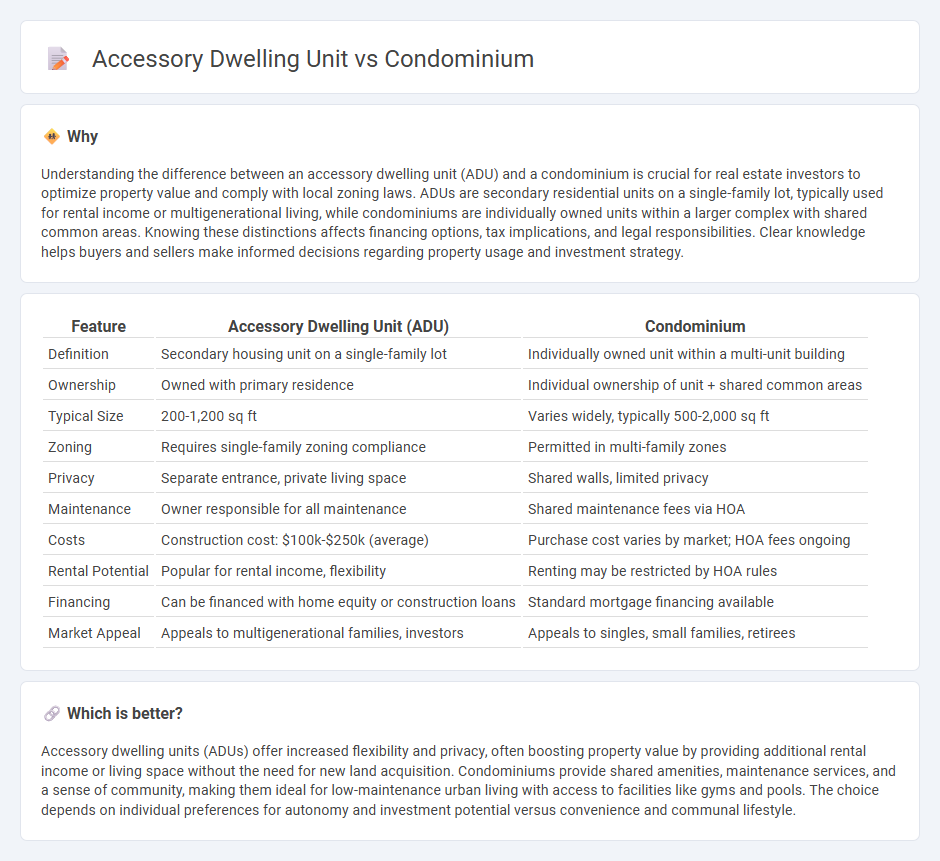
Accessory dwelling units (ADUs) provide homeowners with flexible living spaces often used for rentals or multi-generational living, increasing property value and urban density. Condominiums, on the other hand, offer individual ownership within a shared community structure, including access to amenities and collective maintenance responsibilities. Explore the benefits and considerations of ADUs versus condominiums to determine the best real estate investment for your needs.
Why it is important
Understanding the difference between an accessory dwelling unit (ADU) and a condominium is crucial for real estate investors to optimize property value and comply with local zoning laws. ADUs are secondary residential units on a single-family lot, typically used for rental income or multigenerational living, while condominiums are individually owned units within a larger complex with shared common areas. Knowing these distinctions affects financing options, tax implications, and legal responsibilities. Clear knowledge helps buyers and sellers make informed decisions regarding property usage and investment strategy.
Comparison Table
| Feature | Accessory Dwelling Unit (ADU) | Condominium |
|---|---|---|
| Definition | Secondary housing unit on a single-family lot | Individually owned unit within a multi-unit building |
| Ownership | Owned with primary residence | Individual ownership of unit + shared common areas |
| Typical Size | 200-1,200 sq ft | Varies widely, typically 500-2,000 sq ft |
| Zoning | Requires single-family zoning compliance | Permitted in multi-family zones |
| Privacy | Separate entrance, private living space | Shared walls, limited privacy |
| Maintenance | Owner responsible for all maintenance | Shared maintenance fees via HOA |
| Costs | Construction cost: $100k-$250k (average) | Purchase cost varies by market; HOA fees ongoing |
| Rental Potential | Popular for rental income, flexibility | Renting may be restricted by HOA rules |
| Financing | Can be financed with home equity or construction loans | Standard mortgage financing available |
| Market Appeal | Appeals to multigenerational families, investors | Appeals to singles, small families, retirees |
Which is better?
Accessory dwelling units (ADUs) offer increased flexibility and privacy, often boosting property value by providing additional rental income or living space without the need for new land acquisition. Condominiums provide shared amenities, maintenance services, and a sense of community, making them ideal for low-maintenance urban living with access to facilities like gyms and pools. The choice depends on individual preferences for autonomy and investment potential versus convenience and communal lifestyle.
Connection
Accessory dwelling units (ADUs) and condominiums intersect in urban real estate development by maximizing property value and housing density. ADUs provide additional living spaces on single-family lots, while condominiums offer individual ownership within multi-unit buildings; both address housing shortages through efficient land use and increased occupancy. Local zoning laws often regulate the integration of ADUs within condominium complexes to balance community needs and property rights.
Key Terms
Ownership Structure
Condominiums involve individual ownership of units within a shared building, with common areas jointly owned by all unit owners, while accessory dwelling units (ADUs) are secondary housing units on a single-family property owned outright by the primary homeowner. Condominium owners hold title to their unit and share responsibility for common elements through a homeowners' association, whereas ADU owners control both the main residence and the ADU without a separate ownership entity. Explore detailed comparisons of ownership rights, responsibilities, and legal frameworks for condominiums and ADUs to better understand which option fits your property goals.
Zoning Regulations
Zoning regulations often distinguish between condominiums and accessory dwelling units (ADUs) based on land use, density, and occupancy rules, with condominiums typically subject to stricter subdivision and community association requirements. ADUs are usually categorized as secondary housing units on single-family properties, benefiting from relaxed zoning codes aimed at increasing affordable housing options. Explore local zoning laws further to understand how these regulations impact development and property value.
Homeowners Association (HOA)
Homeowners Associations (HOAs) often impose specific rules and restrictions for condominiums, including shared maintenance responsibilities and amenity usage that impact owners' rights and property values. Accessory dwelling units (ADUs) face varying HOA regulations, which can limit or prohibit their construction due to concerns about density, design compatibility, and neighborhood aesthetics. Explore detailed HOA guidelines and legal considerations to better understand how each housing option affects property use and value.
Source and External Links
Condominium | Wex | US Law | LII / Legal Information Institute - Condominiums are residential developments where each unit owner has title to their unit and shares in common areas through a governing association.
What is a condo? Condominiums defined - Rocket Mortgage - A condominium is a residential complex with individually owned units, where owners pay fees to a homeowners association for shared area maintenance.
Condominium - Wikipedia - A condominium is an ownership regime where a building is divided into multiple units, with each owner having individual ownership and shared rights in common areas.
 dowidth.com
dowidth.com